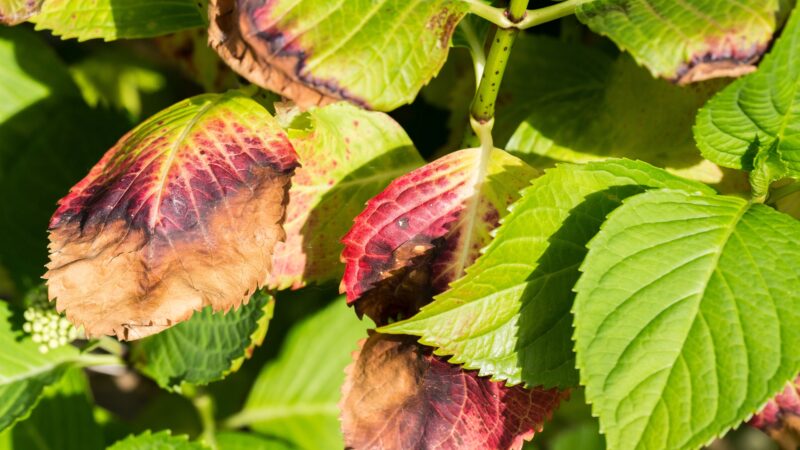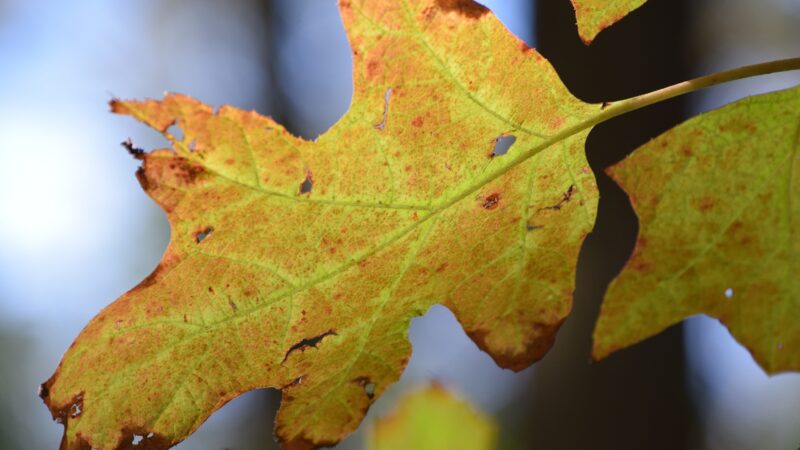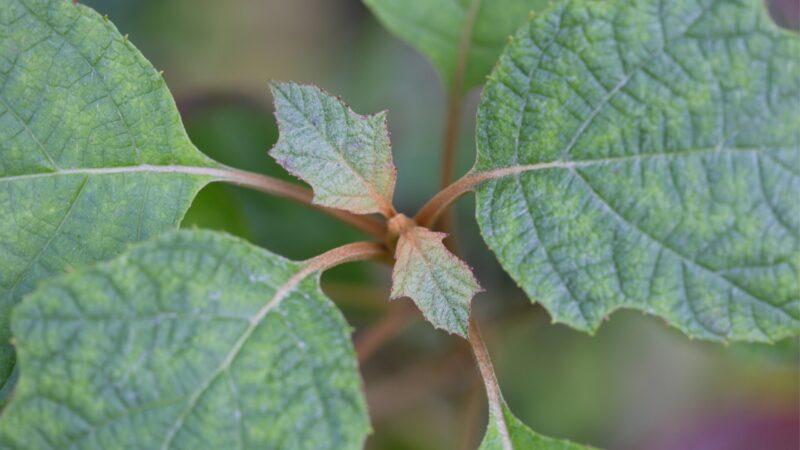There’s something about hydrangea that can take your breath away. With its pastel-colored flowers appearing in a dome-shaped cluster, it’s nature’s way of confirming that its beauty is boundless.
Unfortunately, hydrangea is susceptible to conditions that can cause its leaves to turn brown. And in this article, you’ll learn how to remedy the situation.
With that said, why do hydrangea leaves turn brown? The following are the 7 reasons why hydrangea leaves turn brown:
- It is suffering from low water intake.
- It is exposed to too much sun.
- It is suffering from transplant shock.
- It is overfertilized.
- It is suffering from frost damage.
- It has become a host to fungi or bacteria.
- There is a pest infestation.
All of these reasons will be tackled in depth in this article. You’ll also learn how to remedy each cause of hydrangea leaf browning to help your plant recover.
Most importantly, you’ll also be provided with tips on how to prevent your hydrangea leaves from turning brown. Continue reading for more information.
What Do Hydrangea Leaves Turning Brown Look Like?

Hydrangea has large grayish-green to dark green leaves, although it may turn yellowish, purple, or brown during the autumn and winter months. With that said, brown isn’t the usual color for healthy hydrangea leaves.
When these leaves turn brown, they either look wrinkly or curl inwards. Usually, these brown hydrangea leaves will have a dry texture, which often signifies that the plant did not get enough water.
However, that is not the only cause since hydrangea leaves may also turn brown due to too much exposure to the sun or if they have been exposed to extremely cold temperatures.
Why Are My Hydrangea Leaves Turning Brown?
Aside from lack of water, prolonged sunlight exposure, and extremely cold temperatures, hydrangea leaves may also turn brown because it has been overfertilized or that it has experienced transplant shock. It may also be caused by fungal or bacterial growth, as well as by a pest infection.
Fortunately, each of these reasons has different symptoms, and you’ll learn all about them below.
Low Water
The most common cause for hydrangea leaves turning brown is if it’s not getting enough water. Hydrangeas need a lot of water to be healthy and maintain their beautiful appearance. With that said, their roots need a good soak around three times per week.
When hydrangeas do not get enough water, their leaves start to dry up and turn brown. It will look wrinkly and crispy and would often droop down and look lifeless. If not given immediate care, then these leaves will start to fall off, and your hydrangea plant might even die eventually.
- Causes: The hydrangea plant is not given enough water.
- Remedies: To treat your dehydrated hydrangea, the key is to give it a deep soak – about an inch of water above the soil would do. Allow it to simply soak in the water and rehydrate. Repeat the process a few times a week until the plant looks visibly healthier.
Too Much Sun
Another common cause of hydrangea leaves turning brown is if it’s exposed to the sun for prolonged periods. While hydrangeas need sunlight, they can easily dry up if it is directly under the sun. This can lead to brown spots on its leaves, which will eventually turn dry, brittle, and crispy leaves.
Thus, it is advised to limit a hydrangea’s direct exposure to sunlight. A shaded place in your home or garden that still gets good amounts of indirect sunlight would suffice.
- Causes: This is caused by prolonged exposure of the hydrangea to direct sunlight.
- Remedies: In the case of prolonged exposure to direct sunlight, you should move your hydrangea to a shaded place. Then, immediately give it water, especially if the soil already looks dry.
Another remedy that you can try is to transplant the hydrangea under a tree. The hydrangea will benefit from the shade from the tree’s canopy. Then, water the tree and hydrangea to make sure that it stays hydrated.
Transplant Shock
Like all other plants, hydrangeas also need regular repotting to promote healthy growth. Ideally, it only needs replanting once a year or longer.
In case it has been replanted too frequently, this may result in transplant shock. This not only causes the leaves to turn brown, but it also causes them to curl inwards and look droopy. If it is not given immediate intervention, your hydrangea might die eventually.
- Causes: Transplant shock results from the frequent replanting of hydrangeas. It may also be caused by careless replanting, wherein damage is made to its roots.
- Remedies: In most cases, hydrangea leaves will turn brown in case of transplant shock but will recover in a few days once they have adjusted to the new environment.
To make the new environment less stressful, consider putting it in an area where it receives indirect sunlight, where the temperature is between 50 to 80 degrees Fahrenheit, and with humidity levels at 40%. Also, make sure that it gets watered once to three times a week.
Overfertilized
In general, hydrangeas need a balanced fertilizer to stay healthy. And if you want to speed up the production of its beautiful blooms, then you can use a high-phosphorus fertilizer.
But while fertilizer is good for your hydrangea, too much can lead to its leaves turning brown, especially at the tips. But aside from its leaves, overfertilization of your hydrangea can also burn its roots, which can cause severe damage to your plant.
- Causes: As its name implies, a hydrangea becomes overfertilized if it is given too much fertilizer.
- Remedies: If you can easily distinguish the fertilizer from the soil, then the easiest solution is to remove the excess fertilizer from the pot. While recovering, water it with distilled water to help filter out the nutrients, so the roots do not get burned.
However, if the damage seems too severe, then the only solution is to transfer the hydrangea into a new pot with new soil with no fertilizer. But in doing so, make sure to replant the hydrangea as soon as it is uprooted and do not let it dry up. Otherwise, it might also suffer from transplant shock.
Frost Damage
Another cause for hydrangea leaves turning brown is frost damage. As earlier discussed, hydrangeas do not do well when the temperature drops below 50 degrees Fahrenheit, especially if it is exposed for too long.
When the temperature is too cold, the water inside the hydrangea can freeze over. That affects its growth, thereby resulting in stunted growth, damage to its leaves and other parts, as well as damage to its roots.
- Causes: Frost damage happens when the hydrangea is exposed for extended periods in an area where the temperature is below the plant’s comfortable range.
- Remedies: In the case of frost damage, reviving your hydrangea can be tricky. The only way to do so is to place the plant in an area where the temperature, humidity, and lighting are ideal.
Specifically, the temperature should be between 50 to 80 degrees Fahrenheit, the humidity will not go below 40%, and there is indirect sunlight. During this time, water the hydrangea to help it recover faster.
In the case of severe damage, you can also add in some fertilizer to help it absorb nutrients faster for a speedy recovery. The J R Peters Inc 59324 Jacks Classic No. 7-3-3 Hydrangea Fertilizer contains micronutrients, making it a good option to consider in case of frost damage.
- 7-3-3 Analysis - Great for promoting lush leaves and enhance and...
- Many Ways to Feed - Hydrangea Blue can be used as a foliar or...
- Water-Soluble Powder – Powdered concentrates go further than...
- Included Measuring Spoon – All Jack’s Classic fertilizers...
- Micronutrients - Added micronutrients supply your plant with the...
Nevertheless, prevention is always better than cure. Thus, it’s best to keep your hydrangeas indoors once you notice the temperatures drop – especially during the fall and winter seasons.
Fungus or Bacteria
Because hydrangeas love water, their moist soil tends to attract fungi and bacteria. When it is suffering from a fungal or bacterial infection, hydrangeas will have dry and brown spots on their leaves. In case of severe damage, the leaves will also have holes in them.
- Causes: A hydrangea may suffer from fungal or bacterial growth if it is placed in a place where there is high humidity, or in the case when it has been overwatered, and the soil stays moist for a long time.
- Remedies: In the case of fungal or bacterial infection, the best remedy is to carefully trim the damaged parts. Since hydrangea thrives in moist and humid environments, it will always attract fungi and bacteria. So, you can only prevent it by spraying it with a fungicide like the Garden Safe Brand Fungicide3.
- FOR ORGANIC GARDENING: Can be used up to day of harvest
- INSECTICIDE/FUNGICIDE/MITICIDE: Three garden products in one
- READY-TO-USE SPRAY: Spray for complete coverage of all plant...
- FOR USE ON: Roses, flowers, houseplants, ornamental trees and...
- PREVENTS LISTED FUNGAL DISEASES: Apply weekly to every 2 weeks...
Pest Infestation
Aside from fungi and bacteria, hydrangeas are also attractive to pests. These pests consider the leaves and sap as their food – so in this situation, hydrangeas are simply located at the bottom of the food chain.
Unfortunately, these pests can cause severe damage to your hydrangea, and that can lead to its death if the infestation is not treated immediately.
- Causes: Pests like aphids, beetles, and other bugs feed on the leaves of the hydrangea.
- Remedies: To remedy the situation, the best way is to kill the pests first. To do so, you have to spray your hydrangea with pesticides like Ortho Insect Mite & Disease, which also gets rid of mites and fungi in the process.
- Controls a wide range of fungal diseases and pests
- Controls aphids, mites, beetles, crickets, weevils, silverfish,...
- Controls fungal diseases, including black spot, powdery mildew,...
- Use on roses, flowers, houseplants, ornamental trees and shrubs,...
- Convenient, easy to use, requires no mixing
Once the pests are killed, then it’s advised to carefully remove the parts that were severely damaged and seemingly beyond recovery. Then, continue to give it sunlight and water as usual.
Bear in mind that these pests are naturally attracted to your hydrangea, so the best solution to prevent it from happening is to spray it with pesticides once in a while. This will prevent another infestation from taking place, and your hydrangeas will surely be grateful to you for your extra effort.
Should I Cut Off Brown Hydrangea Leaves?

It depends on how much damage was done to the leaves. If the browning seems to take place during the winter, then it’s most likely part of the hydrangea’s normal life cycle.
Some hydrangea varieties have leaves turning brown during the winter and falling off eventually. In this case, it’s best to leave the plant alone without cutting off the browning leaves.
On the other hand, if the browning seems to be from a pest infestation, frost damage, or fungal growth, it’s best to trim the severely damaged leaves off. This will ensure that the infestation or infection no longer spreads to the healthy parts of the plant.
This also allows the hydrangea to focus on growing and improving its healthy parts. But in doing so, make sure to trim them carefully so as not to damage the plant.
How to Prevent Your Hydrangea Leaves From Turning Brown?

- Water it regularly. As earlier established, hydrangeas need a good amount of water to thrive. With that said, you have to make sure that it gets enough water to prevent the leaves from drying up. A good rule to follow is that it needs around an inch of water at least once to three times a week.
- Give it the right amount of light. Hydrangea needs sunlight to survive. However, it is not advised to place it where it can receive direct sunlight since that will cause the plant to dry up easily. The ideal location will be one that’s shaded, so it still gets enough light without it being too drying. A shaded area in your garden or patio would work best for your hydrangea.
- Make sure it is planted on ideal soil. Hydrangeas love water. As such, it thrives when it is planted on soil that retains moisture. So as much as possible, use clay or compact soil when planting hydrangeas to ensure their good health and longevity.
- Always consider the environmental conditions to maximize its growth. Hydrangeas are subtropical plants. As such, they prefer cooler climates, preferably within the range of 50 to 60 degrees Fahrenheit. While they can tolerate warmer temperatures, they could dry up easily if the temperature exceeds 80 degrees Fahrenheit. Additionally, it is susceptible to frost damage if the temperatures reach sub-zero numbers.
- Monitor the humidity levels. Aside from the temperature, it also helps to monitor the surrounding humidity in the air. Hydrangeas love mild humidity in the air, so it’s best to maintain the moisture levels to around 40 to 45%.
Related: How to Care For Hydrangea Tree? | A Detailed Guide


